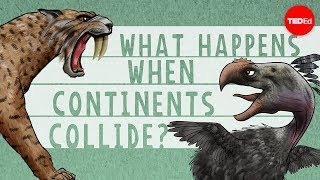(单词翻译:单击)
Tens of millions of years ago, a force of nature set two giant masses on an unavoidable collision course
数千万年前,自然之力致使两块巨型物体无法回避的撞击,
that would change the face of the Earth and spell life or death for thousands of species.
改变了地球的地貌,并决定了数千种生灵的命运。
The force of nature was plate tectonics, and the bodies were North and South America.
这自然之力实为板块漂移,两块巨大的物体则分别为南美洲与北美洲。
And even though they were hurdling towards each other at an underwhelming 2.5 cm per year,
虽然两块大陆仅以每年2.5厘米的速度互相挤压着,
their collision actually did have massive biological reprocussions
南北美洲的撞击事实上对生物造成了巨大影响,
by causing one of the greatest episodes of biological migration in Earth's history: The Great American Biotic Interchange.
造成了地球历史上最壮大的生物迁徙:南北美洲生物大迁徙。
Our story begins 65 million years ago, the beginning of the age of mammals,
我们的故事从六千五百万年前新生代的初期开始,
when what is now North and South America were continents separated by a marine connection between the Pacific and Atlantic Oceans.
那时的南北美洲,是被太平洋与大西洋分开的两块独立的大陆。
During this time, South America was the home of fauna that included armored glyptodonts as large as compact cars,
此时,南美洲是动物的天堂,有如大如汽车的、防卫周全的雕齿兽,
giant ground sloths weighing more than a ton, opossums, monkeys, and carnivorous terror birds.
有重达一吨的巨型地懒,还有负鼠,猴子和肉食性的恐鸟。
North America had its own species, such as horses, bears, and saber-toothed cats.
北美洲也有其独特的生物种,例如马,熊以及剑齿猫。
Over 20 million years, the shifting of the Farallon and Caribbean Plates produced the Central America Volcanic Arc,
超过两千万年前,费拉隆与加勒比板块的移动创造了中美洲火山岛弧,
a peninsula connected to North America, with only a very narrow seaway separating it from South America.
一个与北美洲相连的半岛,此半岛与南美洲间仅有一狭窄的水湾。
As these plates continued to surf the Earth's magma layer far beneath the Pacific Ocean floor,
在比太平洋海床更深处的岩浆层上,这些板块继续移动着,
the Caribbean Plate migrated eastward, and about 15 million years ago,
加勒比板块逐渐东移,终于在一千五百万年前左右,
South America finally collided with this Central American Arc.
南美洲与中美洲岛弧相撞。
This gradually closed the water connection between the Pacific and the Caribbean,
这导致了太平洋与加勒比海间的水路逐渐关闭,
creating a land bridge, which connected North America to South America.
形成了一座连接着南北美洲的陆桥。
Terrestrial organisms could now cross between the two continents,
陆生生物现在可以穿越两大洲,
and from the fossil records, it's evident that different waves of their dispersals took place.
根据化石记载,动物的扩散有着不同的层次。
Even though plants don't physically move,
虽然植物并不能实质上地移动,
they are easily dispersed by wind and waves, so they migrated first, along with a few species of birds.
但是它们易随着风浪飘散,所以植物是最先迁徙的,同时也有一些鸟类。

They were followed by some freshwater fishes and amphibians,
然后是某些淡水鱼与两栖动物,
and finally, various mammals began to traverse the bridge.
最终,各种哺乳动物开始穿越陆桥。
From South America, mammals like ground sloths and glyptodonts were widly distributed in North America.
从南美洲来的哺乳动物,例如地懒与雕齿兽,都广布于北美洲。
Moreover, many South American tropical mammals, like monkeys and bats,
此外,许多南美洲热带哺乳动物,例如猴子与蝙蝠,
colonized the forests of Central America, and are very abundant today.
占据了中美洲的森林,在今天仍大量存在。
South American predator marsupials went extinct 3 million years ago,
有袋动物,南美洲的捕食者,在三百万年前灭绝了,
at which point North American predators, such as cats, bears and foxes,
此时北美洲的捕食者,例如猫科动物,熊与狐狸,
migrated south and occupied the ecological space left behind.
向南部迁徙,占据了有袋动物留下的生态空间。
Horses, llamas, tapirs, cougars, saber-toothed cats, gomphotheres,
马,美洲驼,貘,美洲狮,剑齿猫,嵌齿象
and later humans also headed south across the land bridge.
以及之后的人类,都南下穿过陆桥。
But what happened on land is only half the story.
但是陆地上的故事仅仅是整个故事的一半。
What had been one giant ocean was now two, creating differences in temperature and salinity for the two bodies of water.
当原本巨大的海洋被一分为二时,两个水体有了温度差与盐度差。
The isthmus also became a barrier for many marine organisms,
地峡成为了许多海洋生物的屏障,
like mollusks, crustaceans, foraminifera, bryozoans, and fish, and separated the populations of many marine species.
例如软体动物,甲壳动物,有孔虫,苔藓虫与鱼类,并分离了许多海洋生物的种群。
It also allowed the establishment of the thermohaline circulation, a global water conveyor belt,
分离的海洋导致了温盐环流,一种全球性海水环流带,
which transports warm water across the Atlantic, and influences the climate of the East Coast of North America,
这导致了暖水流穿越大西洋,从而影响了北美东海岸,
the West Coast of Europe, and many other areas.
欧洲西海岸以及其他许多地区的气候。
It's a challenge to track all of the ways the collision of the Americas changed the world,
统计南北美洲撞击给全世界造成的影响是很困难的,
but it's safe to say that the ripples of the Great American Biotic Interchange
但保险地说,南北美生物大迁徙造成的影响
have propagated through the history of life on the planet, and that of mankind.
波及了这个星球上所有的生命体以及人类历史。
What if these species hadn't gone extinct, or if there were no monkeys in Central America, or jaguars in South America?
但是假使这些物种没有灭绝,或者中美洲没有猴子,又或者南美洲没有美洲虎,世界会怎么样?
What if the thermohaline circulation wasn't flowing?
假使温盐环流不存在会怎么样?
Would the East Coast of North America be much colder?
北美洲东海岸会更寒冷吗?
It all goes to show some of the most impactful transformations of our planet
这些都表明了我们星球最有影响力的转变
aren't the explosive ones that happen in an instant, but the ones that crawl towards irreversible change.
往往都不是那些瞬间发生的爆炸性事件,而是那些徐徐而至却无法逆转的事情。
We are the product of history.
我们是历史的作品。


